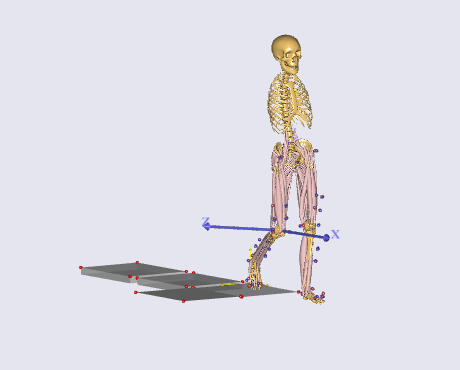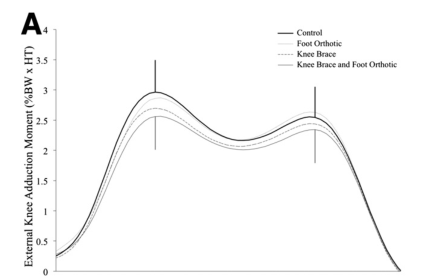Hi
I showed the reference system of KneeNetMoment. The X axis represents the knee flexion moment. Can you tell me what the Y axis and Z axis represent? Thank you very much.

Best regards
zhou
Hi
I showed the reference system of KneeNetMoment. The X axis represents the knee flexion moment. Can you tell me what the Y axis and Z axis represent? Thank you very much.

Best regards
zhou
Hi Zhou,
Z represents flexion moments, x represent varus/valgus moment and y is internal/external rotation.
Best regards
Søren
Hi Søren
Thank you for your reply. So KneeNetMoment.M[0] means varus/valgus moment, but I found that the value has positive and negative. Is there a way to only get the curve of adduction moment? I saw others' curves in the paper is like this.Thank you again.

Best regards
zhou
Hi Zhou,
I am not sure i fully understand, if you see pos and negative values, this is then what the model reports, we do not have a way to change this. That would require a different load/motion.
Best regards
Søren
Hi Søren
Thank you again for your reply. I'm sorry I didn't express my question clearly. I found the problem, there is a model measured in Vicon environment, the coordinate system is different from Plug-in-Gait, causing me to be confused when I see different results. Thank you again for your patience reply.
Best regards
zhou
Hi Søren,
since we are on the topic on knee varus/valgus or ad-/abduction moments:
If I want to calculate the distribution of lateral and medial knee contact forces starting from the knee abduction/adduction moment, similar to what Jonas, John and Skipper did here
should I use:
the knee lateral reaction moment defined in [...].Right.Leg.MomentMeasure.KneeJointReactionMoments.Mlocal[0], which is also reported in the default selected output,
or the component around the x axis of the KneeNetMoment?
I've projected the NetMoment in the same .Thigh.KneeJoint.RotNode ref frame as follows:
Main.HumanModel.BodyModel.Right.Leg.MomentMeasure.KneeNetMoment={ AnyVec3 Mlocal=M*ref.Axes; AnyVar MKneeLateral= - Mlocal[0]; };
The magnitudes of the two moments, after projecting them in the local ref. frame, are actually different.
In the paper above the moment is described as:
MKAA = the abduction/adduction moment about the X-axis, including contributions from external ground reaction loads, muscle forces, inertia forces, gyroscopic forces and gravity.
I thought that the reaction moment computed inside the joint constraints would counteract all these factors, so I was leaning towards using the first option, but now I'm starting to have some doubts about what the differences between the two measures physically mean.
Do you have any suggestion?
Thanks!
Enrico
Hi Enrico,
This is the description from the model. The KneeNetMoment will measure the moments and forces supplied by the muscles spanning the knee and on top of these moments and force the forces and moments from the constraints in the joints will be added. The resulting force and moment are equal to the to total moment and force which could replace both the muscles spanning the joint and the joints reactions.
This is different from the KneeJointReactionMoments which is measuring only the forces and moments in the joint constraint, so this measure will give you the moment carried by the joint it self but at the same time the muscles will carry partly a part of the ad/abduction moment and this is not measured in this measure.
For this purpose you should use the KneeJointReactionMoments but you should possibly use the shank as reference frame instead of thigh.
Best regards
Søren
Hi Søren,
thank you so much. I thought I was supposed to use the reaction moment for this application, but I just wanted to double check.
I also saw the description of the KneeNetMoment in the model files, but I still wasn't sure about its actual applications. Let me try to sum it up, since it might be helpful for others too:
To solve force and moments' balances at a joint level, we should use the KneeJointReactionMoment , and doing so in the shank reference frame makes more sense for the interpretation of knee forces.
The KneeNetMoment represents the total internal knee moment, and therefore it is more suitable in comparisons with total knee external adduction moments, as Zhou was previously asking in this thread. Again, this also requires the projection in a suitable local reference frame.
On the other hand, for moment directions which are unconstrained by the joint, such as knee flexion extension, the KneeNetMoment is generated purely by the muscle moments, therefore looking at the muscle moments which are reported in the Selected Outputs will give equivalent results.
I think my doubts were coming from the wrong thinking logic described here.
I assumed that all the external moment in the frontal plane would have to be counteracted by the joint reaction, since the motion of the joint itself is constrained in that specific direction. However some of the external moments in the frontal plane could be taken up by some of the muscles spanning the knee joint anyway, even if the joint cannot move. It is also important to remember that some of these muscles might be preferably recruited for their 3d orientation to generate a moment mainly in another plane, so we can't really interpret a muscle moment in a single plane anyway, but at least the meaning of the joint output variables are now a bit clearer.. or at least I hope!
Thanks for the help again!
Cheers,
Enrico
Hi Enrico,
Thanks for summarizing this I will add this to our wiki.
I understand your confusion reading the wiki post you linked to so I have tried to make it more accurate.
https://github.com/AnyBody/support/wiki/All-about-Kinetics#does-the-anybody-modeling-system-compute-joint-moments
The post was accurate if considering closed loop problems, like e.g. predicted GRF / interface forces / shoulder complex etc. , but for an open chain model like leg on a force-plate there is a unique solution for the moments.
You are also correct about KneeNetMoment and KneeNetMomentMuscle when the moment are projected to the flexion axis these measures gives identical results.
Best regards
Søren
Hi Søren,
Thanks for all the explanations.
The differences are now much clearer.
Have a good day!
Enrico
This topic was automatically closed 125 days after the last reply. New replies are no longer allowed.